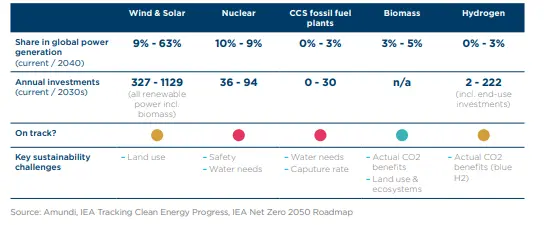Summary
Key takeways
- Although its decarbonisation has been under way for several years now, as highlighted by the strong growth in renewable power capacities, the power sector still accounts for 38% of global energy- and industry-related CO2 emissions.
- The decarbonisation pace of this crucial sector remains too slow compared to scenarios consistent with limiting global warming to +1.5°C.
- Although renewable energies such as wind and solar remain the central piece of the equation, close to 20% of global power supply would need to come from alternative low-carbon power solutions in 2040 according to the IEA NZE 2050.
- In this paper, we assess the decarbonisation potential of four types of solutions and technologies: nuclear power, carbon capture and storage (CCS), woody biomass and low-carbon hydrogen.
- Safe nuclear power has a role to play in the race to Net Zero. However, a nuclear “renaissance” cannot happen without policy support and long-term visibility.
- Although its application to the fossil power sector should remain at margin, Carbon Capture and Storage (CCS) is a much needed technology in the race to Net Zero. The IEA Roadmap counts on it to deliver 9% of the emissions cuts needed by 2035.
- Biomass power capacity needs to rise significantly in almost all scenarios consistent with the 1.5°C temperature target. However, evidence increasingly reveals that woody biomass is on a thin rope to deliver positive contribution to climate goals while limiting risks to ecosystems at the same time.
- We see clean hydrogen as much needed in some hard-to-abate sectors such as steel or chemicals. A great number of key economic and regulatory obstacles have yet to be overcome though, to prove its sustainability case compared to other low-carbon alternatives in several applications.
Low-carbon power: a look beyond wind and solar
- Although its decarbonisation has been under way for several years now, as highlighted by the strong growth in renewable power capacities, the power sector still accounts for 38% of global energy- and industryrelated CO2 emissions.
- The decarbonisation pace of this crucial sector remains too slow compared to scenarios consistent with limiting global warming to +1.5°C. The IEA Net Zero 2050 scenario for instance requires the power sector to reach carbon neutrality as early as 2040. The sector should therefore remain on top of the agenda of investors.
- Although renewable energies such as wind and solar remain the central piece of the equation, close to 20% of global power supply would need to come from alternative low-carbon power solutions in 2040 according to the IEA NZE 2050.
- In this paper, we will focus on the following solutions and technologies:
- Nuclear power
- Carbon capture and storage (CCS)
- Woody biomass
- Low-carbon hydrogen
- Although needed, each of these technologies raise specific challenges that require enhanced due diligence and monitoring by investors for them to actually deliver expected carbon benefits and/ or not compromise other sustainable development goals.





